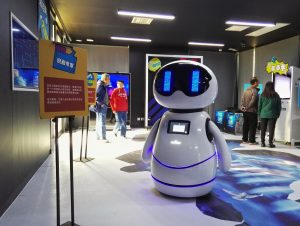In previous articles, I discussed how the recent advancement of generative artificial intelligence (AI) technologies may impact the Chinese state and the Chinese society. In this article, I explore China’s approach to AI research, as well as its implications on the world order.
The recent AI achievement signified by GPT-4 is actually the result of over a decade of intensive fundamental AI research and tens of billions of dollars of investments sponsored by tech giants, such as Microsoft, Alphabet, and Facebook. The two main organizations driving the advancement of generative AI technologies are Alphabet’s DeepMind, which was founded in 2010, and OpenAI, which was founded in 2015 and backed by Microsoft. Both research organizations conducted AI research independently, without their sponsors rushing them toward monetization.
Although there had been many doubts from investors over the spending lavished on these labs without generating profits, persistence finally paid off. OpenAI released ChatGPT and Microsoft immediately integrated ChatGPT into their products. In a quick response, Google was able to release Bard, its own AI chatbot, to compete with Microsoft.
Although China’s tech giants – Baidu, Tencent, Alibaba – all have their own AI labs, they hadn’t been able to develop technologies comparable to ChatGPT. A main reason is that, instead of focusing on independent fundamental research, these Chinese tech giants’ AI labs were founded with the mission to improve the profits of their sponsors. Many AI researchers embed with different business units to provide consulting services for improving revenue and profit of that business unit. It was only after ChatGPT demonstrated its monetization capability that many Chinese tech companies, large or small, quickly jumped onboard to announce their plans for developing the Chinese version of ChatGPT. Another gold rush started.
The fundamental mindset of Chinese tech companies is still driven by short-term profit, and they have always looked to the state to sponsor technological leapfrogs. This has happened in the intelligent electric vehicle (IEV) industry, into which the Chinese government has poured tens of billions of dollars through incentives and subsidies. As a result, China today owns the most complete IEV supply chain in the world, and is the largest IEV market, a huge success by any measure.
Coming back to AI research, instead of providing incentives and subsidies for AI companies, the state has decided to develop AI technologies on its own, through state-sponsored AI labs. Instead of having a few national AI labs, however, the Chinese government chose to launch regional AI research labs, financially backed by resourceful metropolitan governments.
For instance, in 2018, the Beijing metropolitan government and the Ministry of Science and Technology (MoST) jointly supported the establishment of the Beijing Academy of Artificial Intelligence (BAAI) to conduct independent AI research. Then in 2020, the Beijing metropolitan government, MoST, and a few leading universities jointly founded the Beijing Institute for General Artificial Intelligence (BIGAI) to conduct general AI research. In 2020, the Shanghai metropolitan government supported the establishment of the Shanghai Artificial Intelligence Lab (SHLAB) to develop a leapfrog general AI platform. In 2020, the Shenzhen metropolitan government supported the establishment of the International Digital Economy Academy (IDEA) to focuses on cutting-edge research and industrial implementation in the field of artificial intelligence and digital economy. Similarly, many other regional governments also established their own AI research labs.
These major regional AI labs are led by world-class AI experts. For example, BIGAI is led by former UCLA professor Song-Chun Zhu, and IDEA is led by former Microsoft executive Harry Shum.
It appears that 2020 was the year the Chinese government decided to directly sponsor fundamental AI research, instead of providing incentives or subsidiaries for private companies. However, the division of work between the state and the private sector remains the same: The state incubates technological leapfrogs, and the private sector focuses on last-mile commercialization of these advanced technologies.
There are two remaining questions. First, will the state consolidate these regional labs into a national AI research system as general AI technology matures? Second, will these state-sponsored AI labs be converted to state-owned enterprises (SOEs) to provision AI technology?
Facing the current geopolitical situation, state-sponsored AI research may have a profound impact on the future world order. Back in the prime days of globalization, China joined the WTO and has since developed an enormous internal market. It has also incubated the world’s most comprehensive and sophisticated supply chain, ranging from textile products to high-tech products such as IEVs. China’s IEV supply chain in particular will spill over to boost the development of the whole robotics and automation sector, filling the labor gap as China’s population ages. Now, AI is the last piece to complete China’s technological self-reliance.
If the state-sponsored AI research movement is successful, China will be fully ready for a whole new world order, should de-globalization come. In comparison, as indicated by U.S. Senator Marco Rubio in a recent speech, after decades of globalization, the U.S. economy has evolved into one that mainly focus on finance and big tech, whereas manufacturing capabilities have been mostly outsourced to other countries. Thus, the United States may not be as ready as China is for the potential deglobalization.
In summary, state-sponsored AI research is China’s Apollo Program. When the United States was in the space race with the USSR, the success of the state-sponsored Apollo Program – and, more broadly, the U.S. space technology sector – contributed significantly to the end of the Cold War. Now, in the AI race between China and the U.S., AI research will be pivotal for China’s future success – and hence too important to leave in private hands.

































